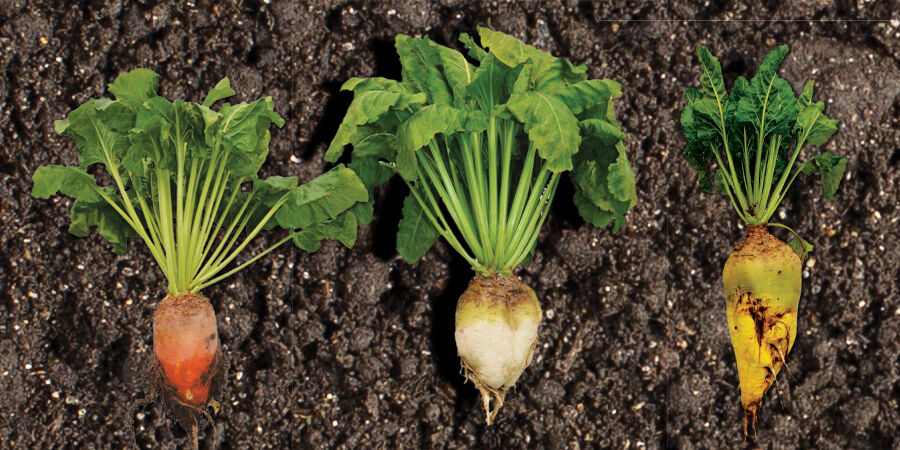
With spring upon us, it is the time to start thinking about fodder beet. A variety of factors come together to achieve the best outcome for your crop, so detailed planning is essential.
Condition of the seedbed, sowing date, soil temperature, cultivar selection, sowing rate, row spacing and depth, and timing of pre-emerge herbicide all influence the yield potential of the crop.
Catalyst’s team of agronomists are specialists in bringing all of these pieces of the puzzle together with a high level of attention to detail. Growing exceptional fodder beet crops in the South Island has been a major focus for the business for many years. Catalyst agronomists have the passion to achieve the best outcome for their customers.
The fodder beet cultivars Catalyst will be managing for its customers in the 2024-2025 season include:
Gustea
Gustea is a recently bred high dry matter (20-22 percent) fodder beet. Gustea sits approximately 30 percent above the ground and has very strong disease and bolting tolerance. It is best suited for farmers who want to lift and feed fodder beet to stock, although under certain conditions it can be grazed in-situ by some classes of stock. Gustea is exclusive to Catalyst Performance Agronomy.
Feldherr
Feldherr has a low bulb dry matter percentage (12-15 percent), which some farmers prefer for grazing. Feldherr can produce large bulbs and high yields for its type with an abundance of leaf growth. It is suitable for all classes of stock, particularly young stock, older animals, and deer.
Bangor
Bangor is a uniform fodder beet with a medium-bulb dry matter percentage (16-18 percent), and a high yield potential. Approximately half the bulb sits above ground and is yellow in appearance.
Geronimo
Geronimo’s origins trace back to France. It is identifiable by its yellow-orange tankard shaped bulb. This variety is known for its tolerance to diseases such as ramularia and mildew. It is versatile across various grazing applications and can be grazed in-situ, lifted or fed whole or chopped.
Enermax
One of the highest yielding beet cultivars in the New Zealand market. Enermax consistently produces uniform bulbs in terms of size and height. It is suitable for in-situ grazing or lifting with all stock classes. It takes approximately 200 days to mature with around 45 percent of the bulb above ground and produces +/- 19 percent dry matter.
Delicante
A recently released high yielding monogerm variety. Suitable for grazing in-situ or can be mechanically lifted. It has exceptional leaf retention and when compared to Enermax sits higher above ground. Dry matter percentages are +/- 18 percent.
SF1505
This variety is a genetic mono-germ hybrid-type fodder beet. It offers medium to high dry matter ensuring maximum yield potential. SF1505 will suit both grazing in-situ or self-harvesting, ensuring feeding system versatility. It offers a high leaf-to-bulb ratio which makes it suitable for a range of grazing systems.
Lactimo
A mono-germ fodder beet with a yellow/orange bulb, Lactimo sits 50 percent above the ground. It produces large tops with a medium dry matter content of +/- 16 percent. Subject to management and climatic conditions its bolting tolerance is very good, as is its disease tolerance. Lactimo is exclusive to Catalyst Performance Agronomy.
Anselmo
Anselmo is a newly released medium dry matter variety. It is a yellow-orange bulb and has a dry matter range of +/- 16 percent. Anselmo sits 50% above the ground. In trials it has performed very well in particular with its leaf disease score. Anselmo is exclusive to Catalyst Performance Agronomy.
New Seed Treatment Options
Rampart Fungicide
A newly introduced fungicide treatment which has control over Rhizoctonia. Rampart is a locally systemic fungicide treatment which has both preventative and suppressive activity. It has been extensively trialled in Europe and the USA. It provides up to 4 weeks protection which in most cases is the danger period for Rhizoctonia damage occurring.
Cruiser Insecticide
Cruiser (Thiamethoxam) is an insecticide which has been widely used on fodder beet in New Zealand. This year we have certain varieties which have triple the rate of active ingredient. This will provide added protection in the early stage of plant growth prior to topical insecticide applications. The Beet Western Yellows Virus which is caused by aphids is a prominent issue to Fodder Beet health. Utilising this seed treatment will aid in the combat against aphids.